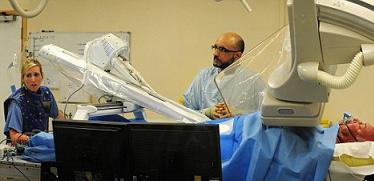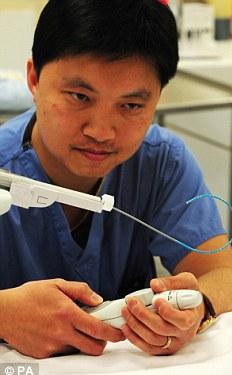
On April 28th, for the first time ever, a British doctor at Leicester’s Glenfield Hospital used a catheter robot to perform heart surgery on a patient while not in the operating room. The Remote Catheter Manipulation System (RCMS), developed by Catheter Robotics in the US, feeds a long thin wire (catheter) from a vein in the patient’s groin up to the heart where it uses electrodes to stimulate and then heal the heart by selectively burning tissue. This operation is used to correct an irregular heartbeat. Typically, the catheter is fed into the body by hand, but the robot allowed surgeon Andre Ng to perform the operation from outside the OR. That’s a great advantage to the doctor as this enabled him to avoid the 250+ X-rays exposures that are used during the operation to monitor inside the patient’s body. The RCMS also helped speed up the process considerably. This success is another sign of the rise in robotic surgery all across the world. We’ve got a great video about the operation for you after the break.
The use of robots in hospitals has been increasing for decades. The DaVinci robot is already used in the vast majority of prostate surgeries in the US. Catherine Mohr, one of the pioneers in the field, has long predicted that they will come to dominate surgeries in the future. All of the systems currently in use are almost completely remote controlled. Some controls are very complex, the DaVinci has a stereoscopic work station and two control arms, while others are fairly simple, Dr. Ng used two buttons to change the direction of the catheter, and thread it into and out the patient. Eventually, however, there will just be one button: “go”. Robots won’t simply turn surgery into a video game, they’ll actually perform the entire operation with a minimum of human guidance.
Many of the headlines surrounding Dr. Ng’s success has referred to this as the “first robotic heart surgery” or some variation thereof. That’s a negligent way of phrasing things. Heart surgeries have been performed using remote controlled robot arms for several years (often via the DaVinci system). In fact, it’s not even the first surgery using a robot catheter. As far as I can tell, what is unique about the Leicester operation was that it was the first using a robotic catheter with such simplified controls and that a surgeon performed this type of correction for arrhythmia while outside the OR.

Despite my frustration at these headlines, this operation still is an important first. Getting surgeons out of the OR not only saves them from risky radiation exposure, it heralds a time when any surgery can be performed by a surgeon located anywhere in the world. After all, Dr. Ng performed the operation via computer monitors and a remote control, he could have easily been in another country as another room (given the appropriate secured internet connection).
While the day of universal robotic surgery is still rather far off, I’m amazed by how relatively cheap and easy it is to use one of these catheter robots. While the price tag may seem steep ($540,000 or £350,000) it’s not outrageously expensive for hospital equipment. Furthermore, doctors already familiar with the catheter operation should be able to convert to the robotic system with a minimum of training because of its simple controls.
The advantages of robot surgery are increasing. These machines allow for surgeries to be performed with small incisions (sometimes only one) rather than opening the entire chest. They can prevent surgeons from receiving repeated exposure to radiation. Robots may also allow for long distance remote control, giving patients a wider range of surgeons to select from. In the end, these advantages are likely to bring more and more robotics into the OR, and robots may become the tool of choice for most surgeries. Eventually the sophistication of these systems will allows them to meet and then exceed the talents of human surgeons in all but the most creative of operations. Dr. Ng’s work saw a remarkable achievement with a procedure performed through a robot. Soon, however, we will see procedures performed by a robot. That, my friends, will be the start of amazing things.
[image credits: Press Association]
[source: Daily Mail, This is Leicestershire]



